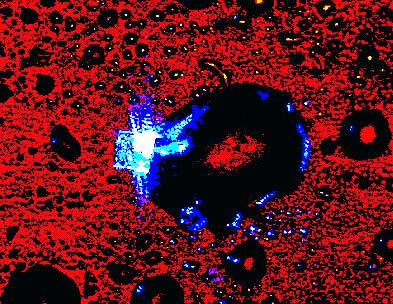The Whole Picture

A 100-micron-wide drop of glycerin (dark ellipse) acts as a parabolic focusing mirror in a new technique that can reveal details smaller than a wavelength of light using an ordinary microscope. (The blue is scattered laser light). Image Credit: Phys. Rev. Lett. 94, 057401 (2005)
Biologists dream of a point-and-shoot camera that can reveal details smaller than a wavelength of light in living cells. Now researchers show that "two-dimensional" light--short-wavelength light waves that live on a surface--can improve resolution without the expensive equipment and special preparations needed for electron microscopes and other technologies. The team imaged nanoscale holes as a demonstration, but they believe the technique could ultimately take instant shots and even movies of the biological nanoworld .
Read more about this research at Physical Review Focus.
Text courtesy of Physical Review Focus.











